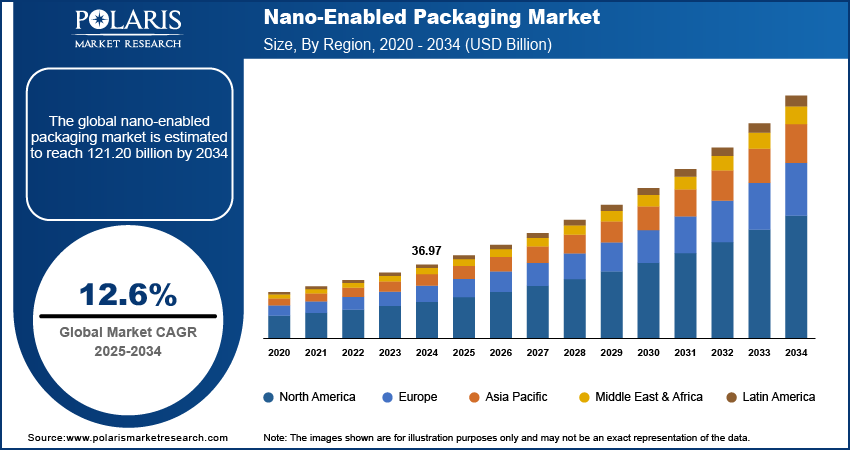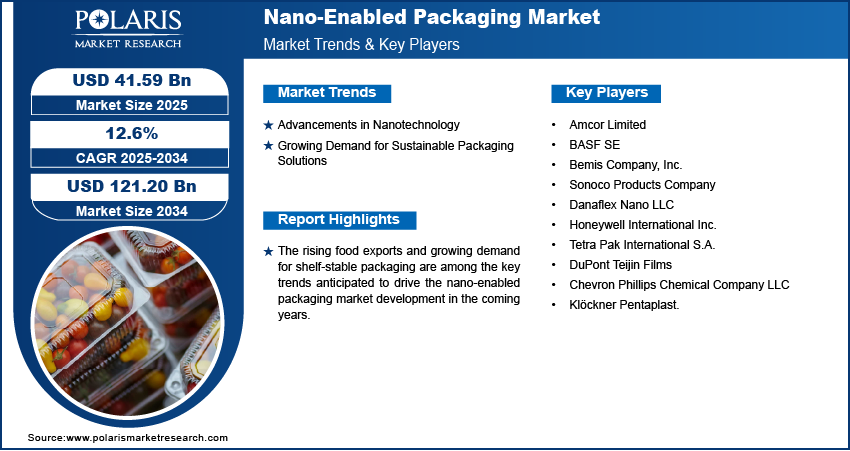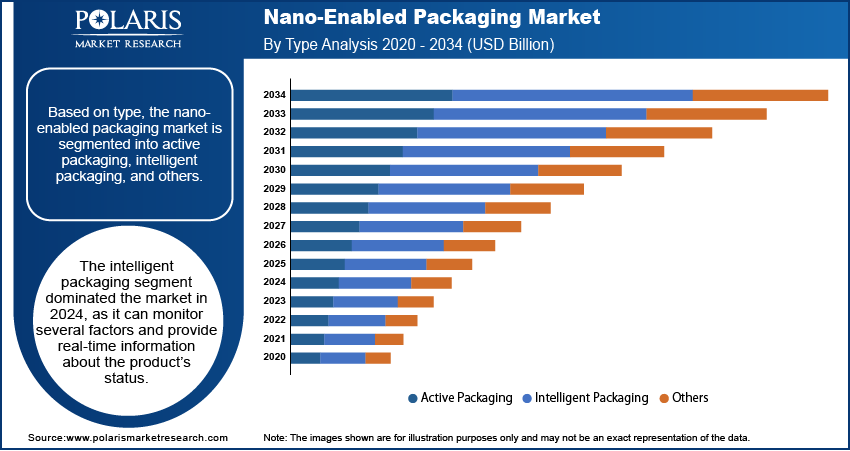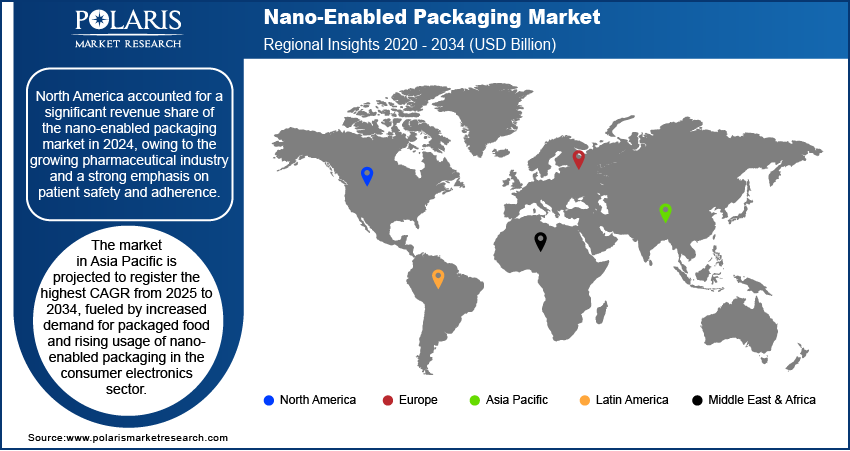
Nano-Enabled Packaging Market Size, Share, Trends, Industry Analysis Report: By Type (Active Packaging, Intelligent Packaging, and Others), End-Use Industry, and Region (North America, Europe, Asia Pacific, Latin America, and Middle East & Africa) – Market Forecast, 2025–2034
- Published Date:Jan-2025
- Pages: 119
- Format: PDF
- Report ID: PM1577
- Base Year: 2024
- Historical Data: 2020-2023
Nano-Enabled Packaging Market Overview
The global nano-enabled packaging market size was valued at USD 36.97 billion in 2024. The market is projected to grow from USD 41.59 billion in 2025 to USD 121.20 billion by 2034. It is projected to exhibit a CAGR of 12.6% from 2025 to 2034.
Nano-enabled packaging refers to the use of nano-materials, which have a diameter of less than 100 nanometers, for the development of packaging solutions. These solutions are mainly used in the food & beverages and pharmaceutical industries. The packaging solutions can extend the shelf life of perishable foods and beverages while also preserving key qualities such as taste, texture, color, and consistency of food products.

To Understand More About this Research: Request a Free Sample Report
The use of nano-materials such as nanoclay, silver, and titanium nitride reduces the risk of contamination and helps preserve and maintain the nutrients in food products. In addition, nano-enabled packaging incorporates nanosensors to monitor both internal and external conditions of food products throughout the entire supply chain. These sensors are designed to change color upon detecting contaminants.
The increasing demand for packaged food products and the implementation of favorable government initiatives to promote the use of nano-enabled packaging are among the key factors driving the nano-enabled packaging market growth. Rising digitalization, increasing use of nano-enabled packaging in the pharmaceutical sector, and the ongoing development of intelligent packaging also support market development. Other factors influencing the rising adoption of nano-enabled packaging are increasing urbanization, demographic and socio-economic changes, and improved economic conditions in developing economies.
The growing demand for shelf-stable packaging and rising food exports are among the key trends anticipated to influence the nano-enabled packaging market development in the coming years. The growth in packaging consumption, increasing demand for anti-counterfeit products, and the need to prevent contamination in food and beverages are likely to provide various nano-enabled packaging market opportunities during the forecast period.
Nano-Enabled Packaging Market Dynamics
Advancements in Nanotechnology
Advancements in nanotechnology have led to the creation of packaging materials with several innovative properties. For instance, nano-materials, which are engineered at the nanoscale level, exhibit exceptional resistance to external factors such as oxygen, moisture, and contaminants. The use of nanosensors can help detect and measure parameters such as freshness, temperature, humidity, and gas concentration in packaged products. Nano-emulsion can encapsulate and protect food products, enhancing their stability and extending their shelf life. Thus, progress in nanotechnology is driving the nano-enabling packaging market demand.
Growing Demand for Sustainable Packaging Solutions
Rising concerns about increasing pollution levels and climate change, along with growing awareness about the harmful effects associated with traditional plastic packaging, have led to the emergence of sustainable alternatives. In this facet, nano-enabled packaging is considered an eco-friendly option, as it can be made from biodegradable materials. The use of biodegradable materials can improve the biodegradability of the packaging and help reduce the amount of plastic waste and carbon footprint globally. Thus, the growing demand for sustainable packaging solutions contributes to the nano-enabled packaging market expansion.

Nano-Enabled Packaging Market Segment Insights
Nano-Enabled Packaging Market Outlook by Type Insights
The nano-enabled packaging, based on type, is segmented into active packaging, intelligent packaging, and others. The intelligent packaging segment dominated the market with a revenue share of 87.1% in 2024. Intelligent nano-enabled packaging uses nanotechnology and smart sensing technology for monitoring and tracking the quality of perishable goods. The packaging can be equipped with sensors that can monitor factors such as oxygen and moisture levels to indicate when a product is going to be damaged. Also, it provides real-time information about the product’s status, thereby improving supply chain management. These benefits of intelligent packaging drive its dominance in the market.
Nano-Enabled Packaging Market Assessment by End-Use Industry Insights
The nano-enabled packaging market, based on end-use industry, is segmented into food and beverages, pharmaceutical, personal care, and others. The food and beverages segment led the market with a revenue share of 36.8% in 2024. The growing consumption of packaged food products and the rising preference for sustainable and shelf-stable packaging solutions are driving the demand for nano-enabling packaging solutions in the industry. In addition, the shifting consumer preferences for fresh and healthy food products with extended shelf life underscores the robust growth of the segment.

Nano-Enabled Packaging Market Regional Analysis
By region, the market report offers nano-enabled packaging market insights into North America, Europe, Asia Pacific, Latin America, and the Middle East & Africa. North America accounted for a revenue share of 31.10% in 2024. The growing pharmaceutical industry, strong emphasis on patient safety and adherence, and stringent regulatory standards ensuring top-notch packaging quality are among the key factors driving the nano-enabled packaging market expansion in North America. In addition, the rising demand for convenient and creative packaging solutions drives the regional market development.
The nano-enabled packaging market in the Asia Pacific is projected to register the highest CAGR of 12.5% from 2025 to 2034. The increased demand for packaged food in the region has prompted the need for advanced packaging solutions that help maintain product integrity, quality, and safety. Also, the rising usage of nano-enabled packaging in the consumer electronics sector contributes to market expansion in the region.

Nano-Enabled Packaging Market – Key Players and Competitive Insights
The market for nano-enabled packaging is characterized by intense competition, driven by various factors such as innovative product offerings, technological advancements, mergers and acquisitions, and strategic partnerships. The key players in the market strive to differentiate themselves in terms of pricing, quality, offering, and customer service. Also, they are making significant investments in R&D initiatives to introduce new packaging solutions to cater to diverse consumer needs.
Several market participants are prioritizing the development of sustainable and eco-friendly nano-enabled packaging products that comply with stringent government regulations. The nano-enabled packaging market report offers a market assessment of all the leading market players, including Amcor Limited; BASF SE; Bemis Company, Inc.; Sonoco Products Company; Danaflex Nano LLC; Honeywell International Inc.; Tetra Pak International S.A.; DuPont Teijin Films; Chevron Phillips Chemical Company LLC; and Klöckner Pentaplast.
List of Key Players in Nano-Enabled Packaging Market
- Amcor Limited
- BASF SE
- Bemis Company, Inc.
- Sonoco Products Company
- Danaflex Nano LLC
- Honeywell International Inc.
- Tetra Pak International S.A.
- DuPont Teijin Films
- Chevron Phillips Chemical Company LLC
- Klöckner Pentaplast.
Nano-Enabled Packaging Industry Developments
June 2024: Sonoco, a leading sustainable packaging provider, announced the acquisition of Eviosys, a metal packaging company. With the acquisition, Sonoco aims to establish itself as the leading producer of metal food cans and aerosol packaging solutions.
March 2023: Amcor, a global provider of responsible packaging solutions, revealed its joint research project agreement with Nfinite Nanotechnology Inc. The company stated that the agreement aims to validate the use of Nfinite’ coating technology to improve compostable packaging and recycling.
Nano-Enabled Packaging Market Segmentation
By Type Outlook
- Active Packaging
- Intelligent Packaging
- Others
By End-Use Industry Outlook
- Food and Beverages
- Pharmaceutical
- Personal Care
- Others
By Regional Outlook
- North America
- US
- Canada
- Europe
- Germany
- France
- UK
- Italy
- Spain
- Netherlands
- Russia
- Rest of Europe
- Asia Pacific
- China
- Japan
- India
- Malaysia
- South Korea
- Indonesia
- Australia
- Rest of Asia Pacific
- Middle East & Africa
- Saudi Arabia
- UAE
- Israel
- South Africa
- Rest of Middle East & Africa
- Latin America
- Mexico
- Brazil
- Argentina
- Rest of Latin America
Nano-Enabled Packaging Market Report Scope
|
Report Attributes |
Details |
|
Market Size Value in 2024 |
USD 36.97 billion |
|
Market Size Value in 2025 |
USD 41.59 billion |
|
Revenue Forecast by 2034 |
USD 121.20 billion |
|
CAGR |
12.6% from 2025 to 2034 |
|
Base Year |
2024 |
|
Historical Data |
2020–2023 |
|
Forecast Period |
2025–2034 |
|
Quantitative Units |
Revenue in USD billion and CAGR from 2025 to 2034 |
|
Report Coverage |
Revenue Forecast, Market Competitive Landscape, Growth Factors, and Trends |
|
Segments Covered |
|
|
Regional Scope |
|
|
Competitive Landscape |
|
|
Report Format |
|
|
Customization |
Report customization as per your requirements with respect to countries, regions, and segmentation. |
FAQ's
The market was valued at USD 36.97 billion in 2024 and is projected to grow to USD 121.20 billion by 2034.
The market is projected to register a CAGR of 12.6% from 2025 to 2034.
North America accounted for a significant revenue share of the market in 2024.
A few of the key players in the market are Amcor Limited; BASF SE; Bemis Company, Inc.; Sonoco Products Company; Danaflex Nano LLC; Honeywell International Inc.; Tetra Pak International S.A.; DuPont Teijin Films; Chevron Phillips Chemical Company LLC; and Klöckner Pentaplast.
The intelligent packaging segment held the largest market share in 2024.
The food and beverages segment led the market in 2024.
